Abstract
The article presents a synthesis of present knowledge concerning sandflies of the family Phlebotomidae in relation to leishmaniasis. Over 500 species of Phlebotominae are known, most of which belong to the genera Phlebotomus and Sergentomyia in the Old World and Lutzomyia in the New World. Phlebotomus is the dominant genus in the palaearctic region, extending also into the other regions of the Old World where Sergentomyia is the principal genus. Sandflies are of little importance in temperate North America but in tropical America Lutzomyia is the main genus and is found over large areas. The distribution of sandflies largely determines the occurrence of leishmaniasis. Certain species of Phlebotomus and Lutzomyia transmit dermal leishmaniasis in large areas of the palaearctic and neotropical regions. Visceral leishmaniasis is transmitted by some species of Phlebotomus in much of the palaearctic region, except desert areas of North Africa, and in limited areas of Africa and India, and by a species of Lutzomyia in north-eastern Brazil. Sandflies are quite likely to bite man in the open country of much of the Old World; they tend however to be localized in distribution on account of their need for a suitable microhabitat (e.g., the burrow of the Central Asian large gerbil, which has been extensively studied in relation to dermal leishmaniasis). It is noted that the distribution of sandflies and leishmaniasis appears to be changing.
A few species of sandfly are regarded as proved vectors of human leishmaniasis according to five criteria; other species which are the only man-biting sandflies in the area are probably vectors. Although it is not possible to make a clear-cut list of vectors, a table of some proved and suspected vectors is included.
Full text
PDF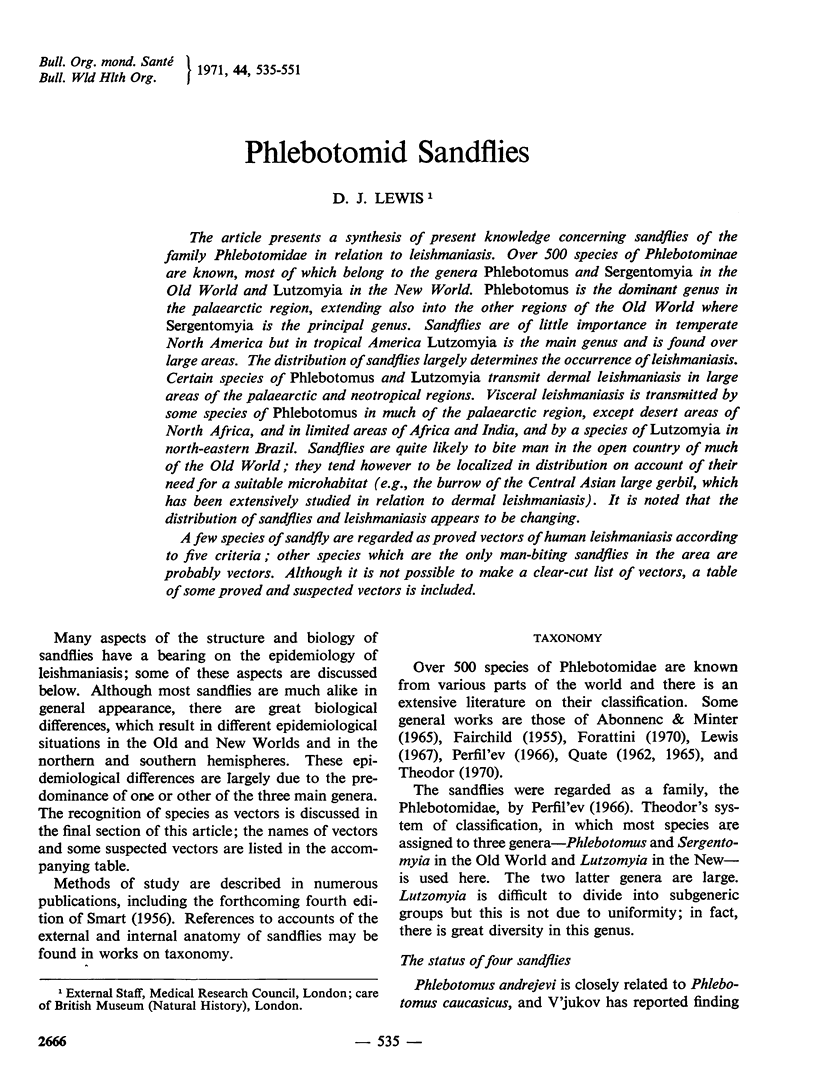
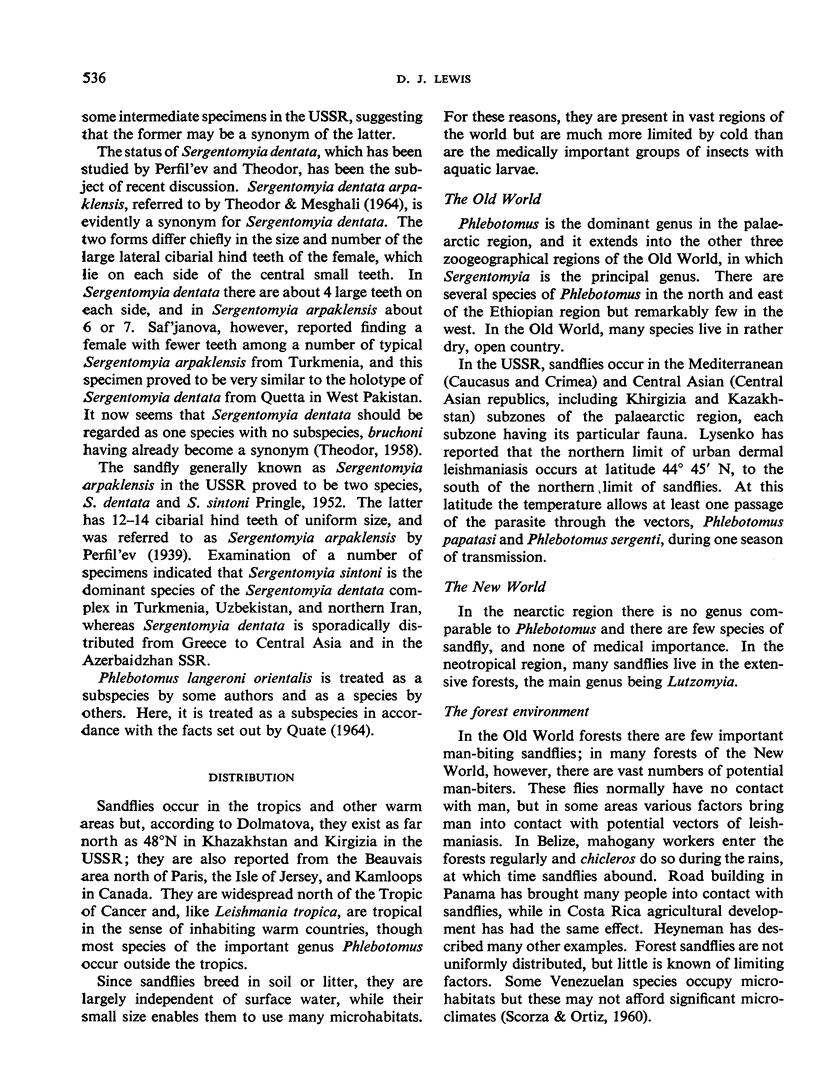
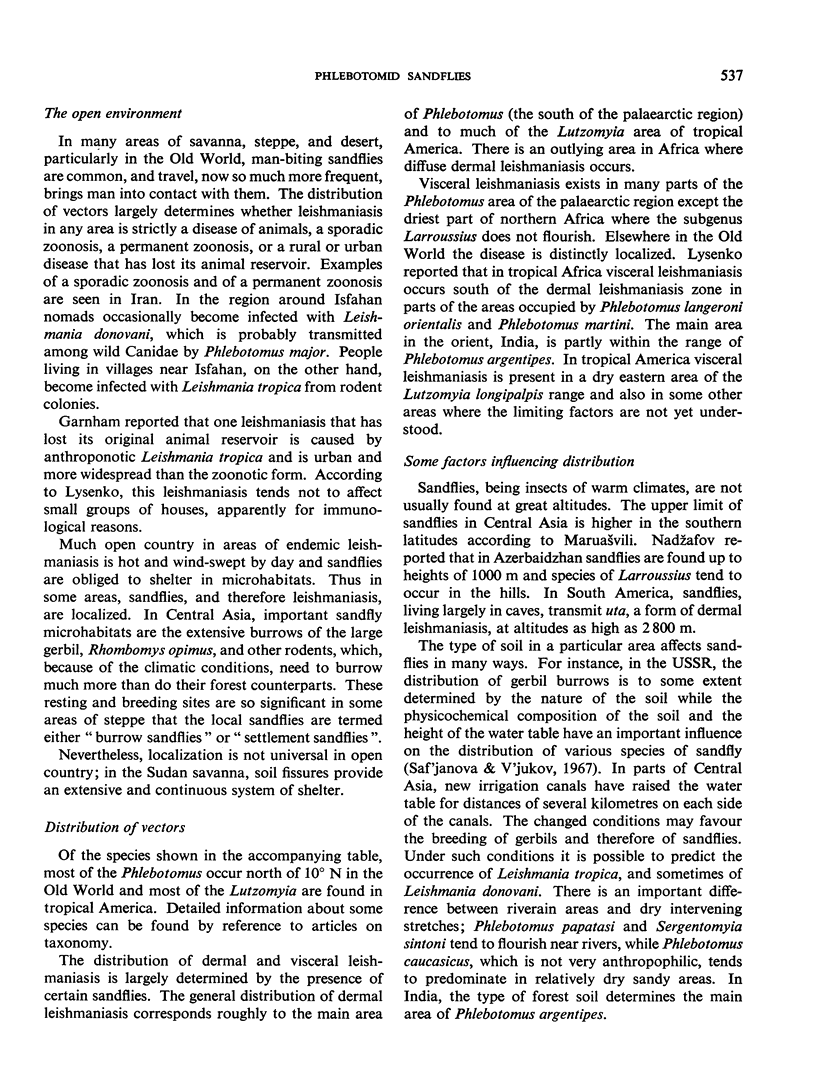
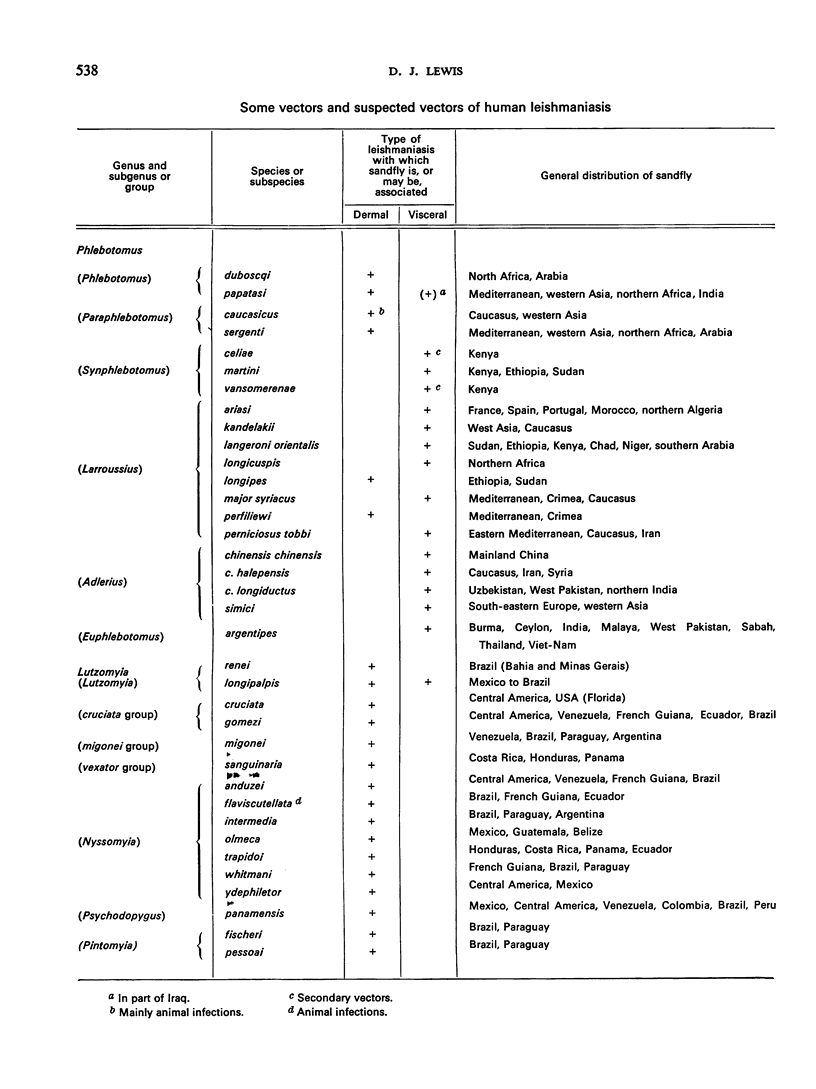
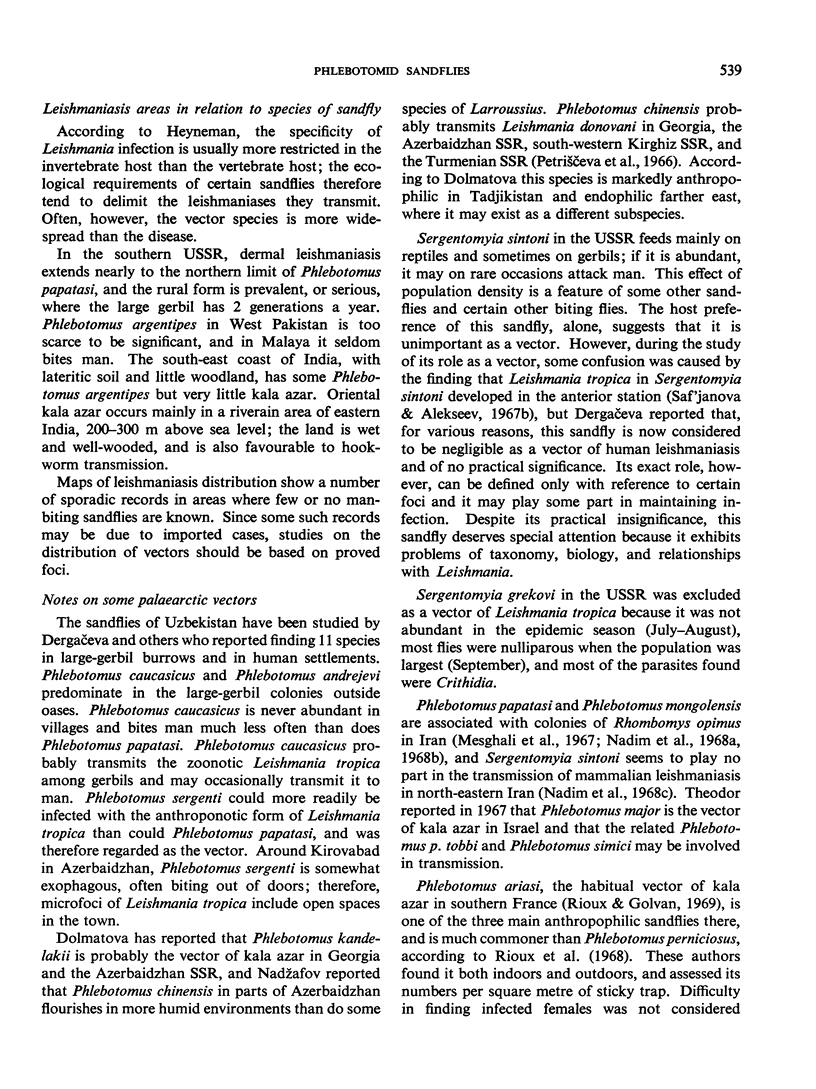
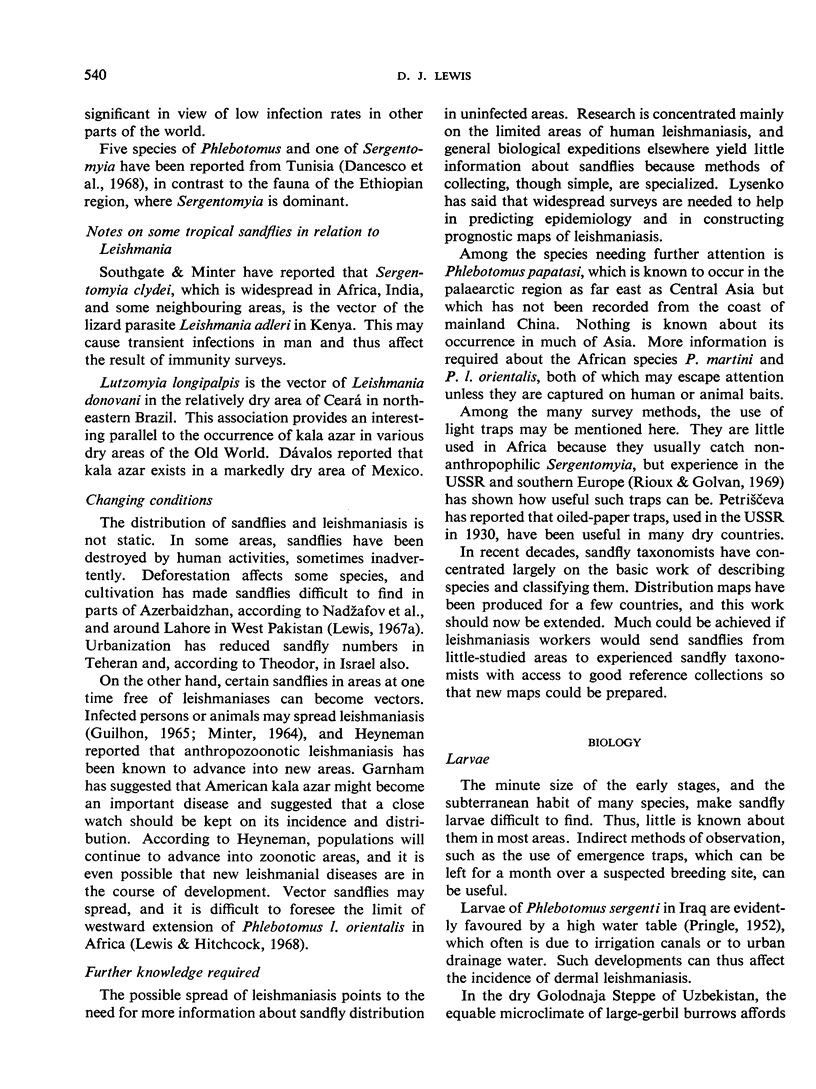
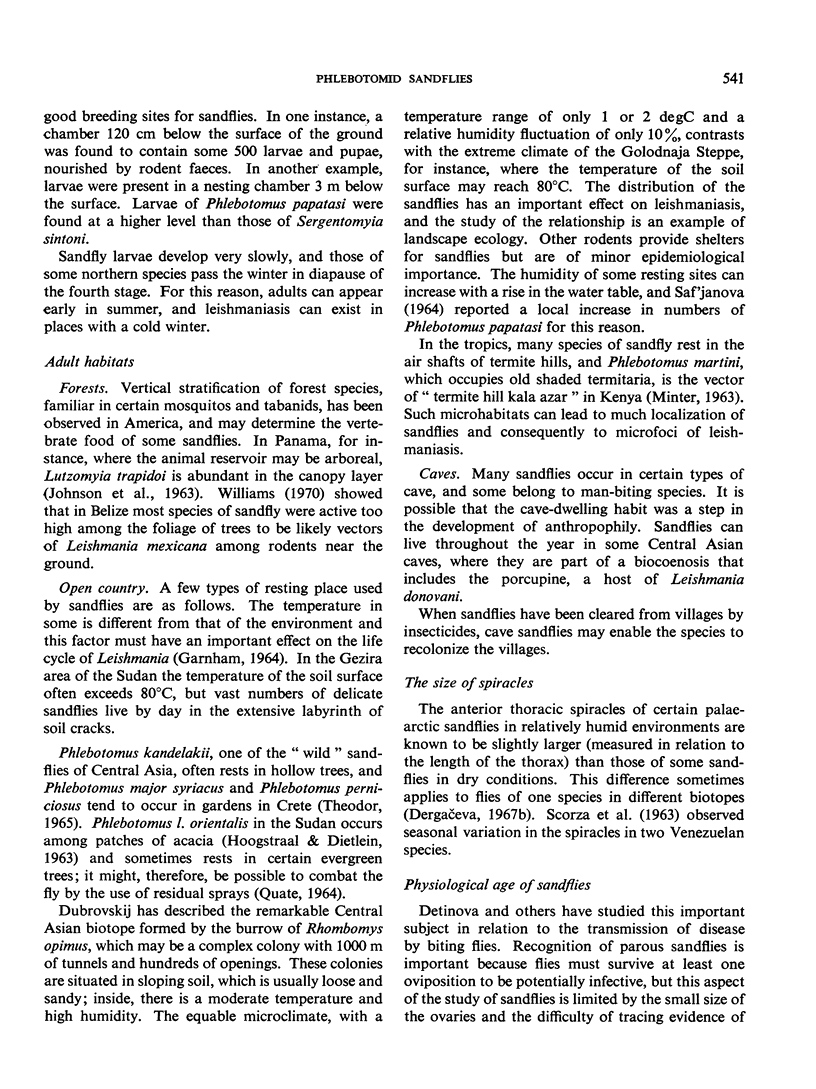
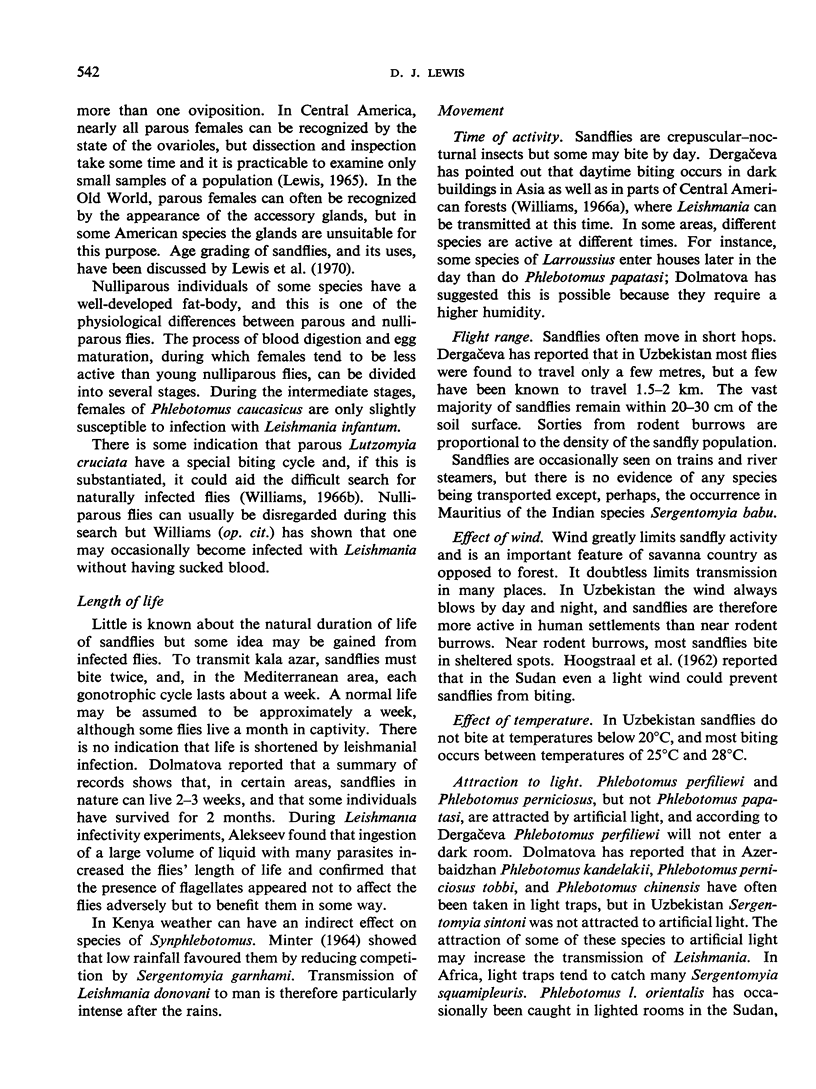
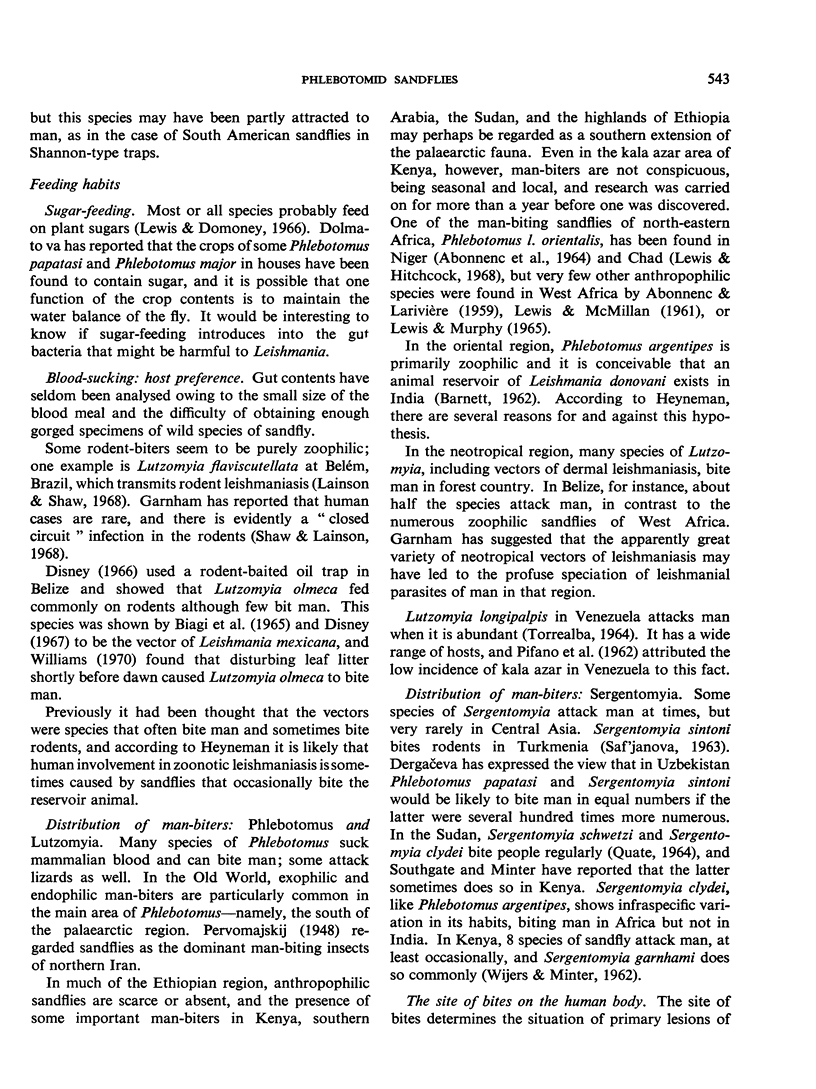
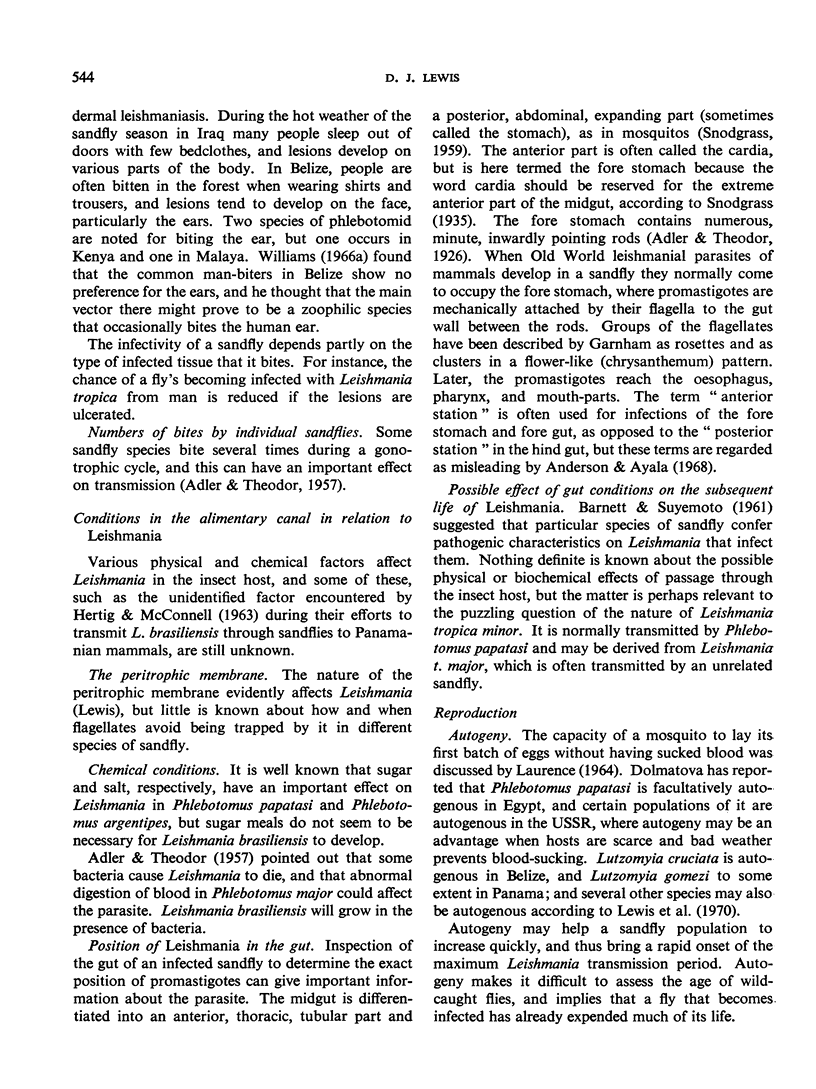
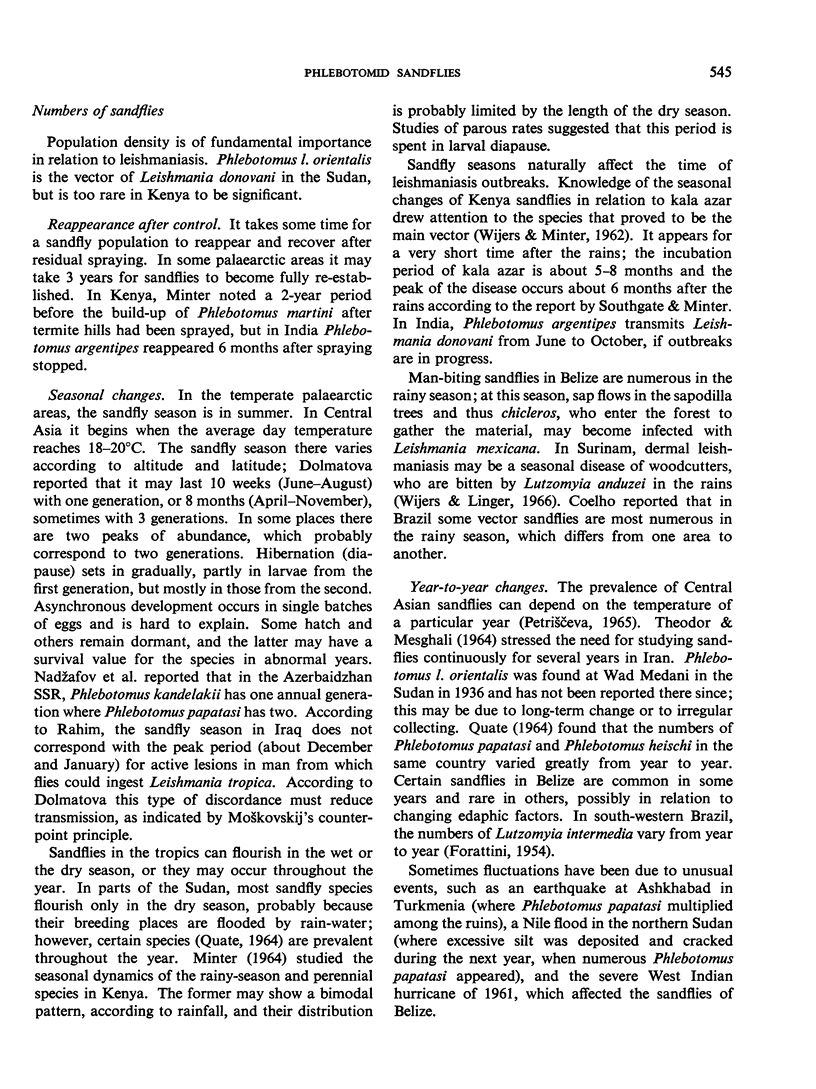
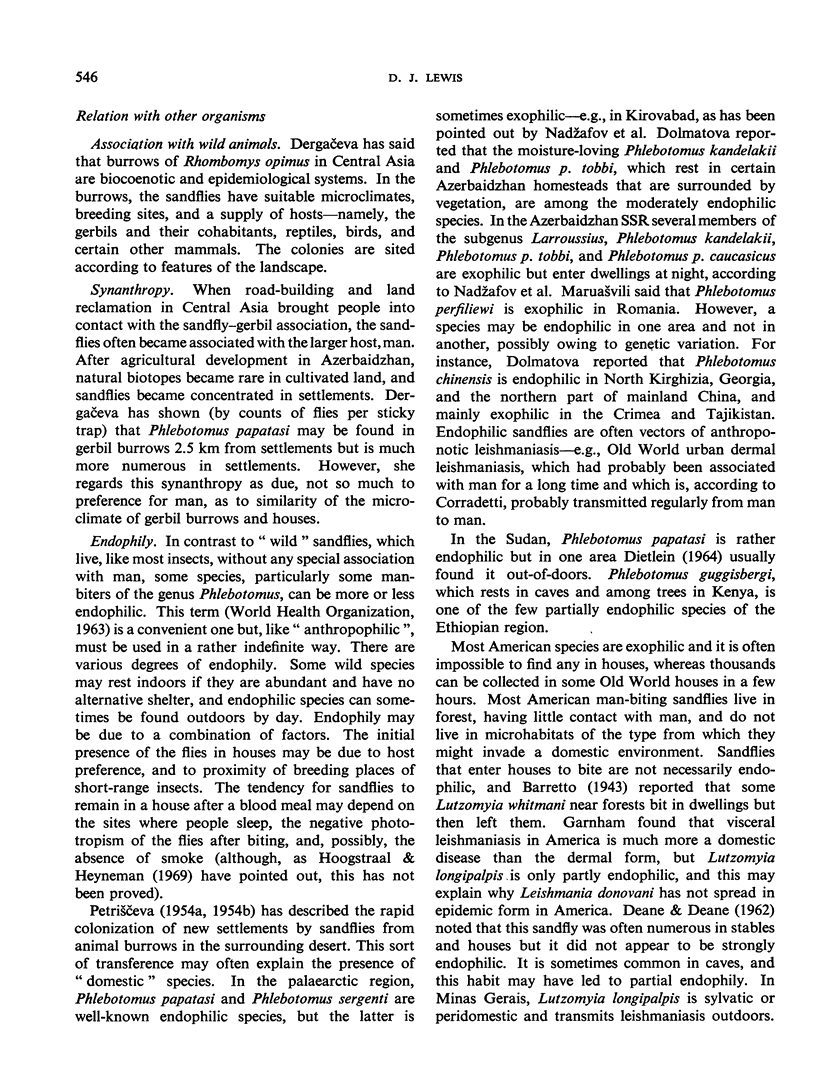
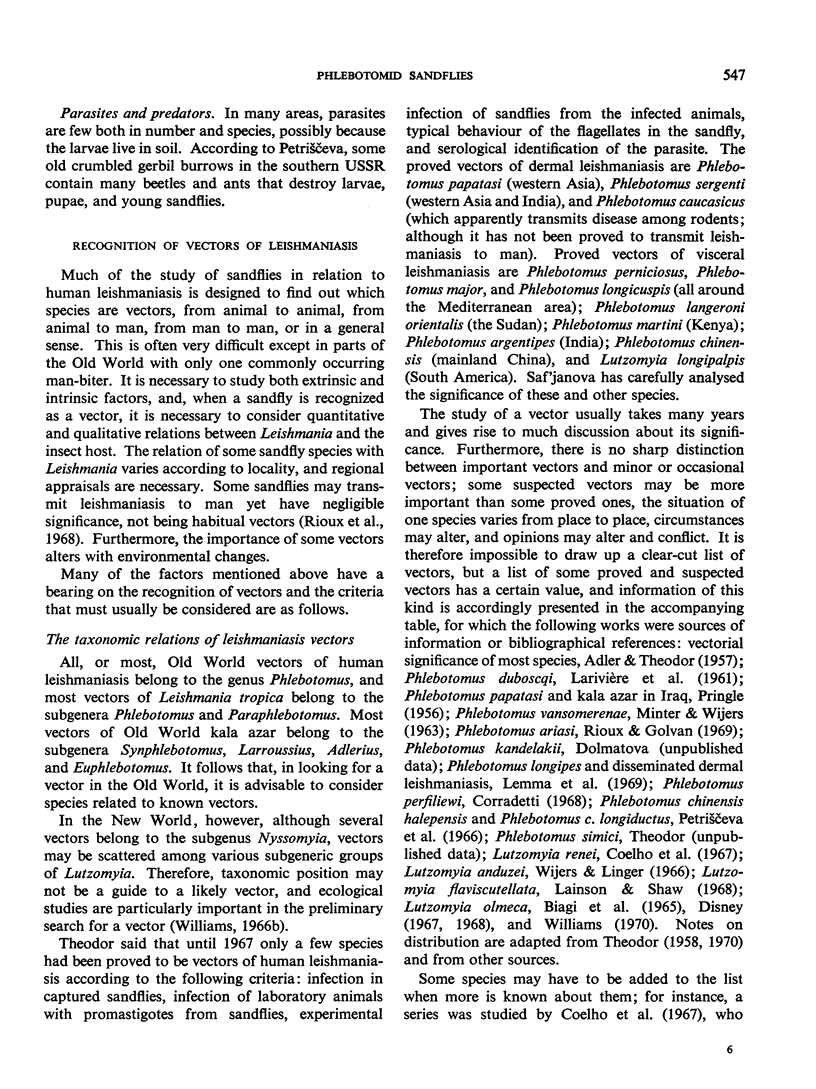
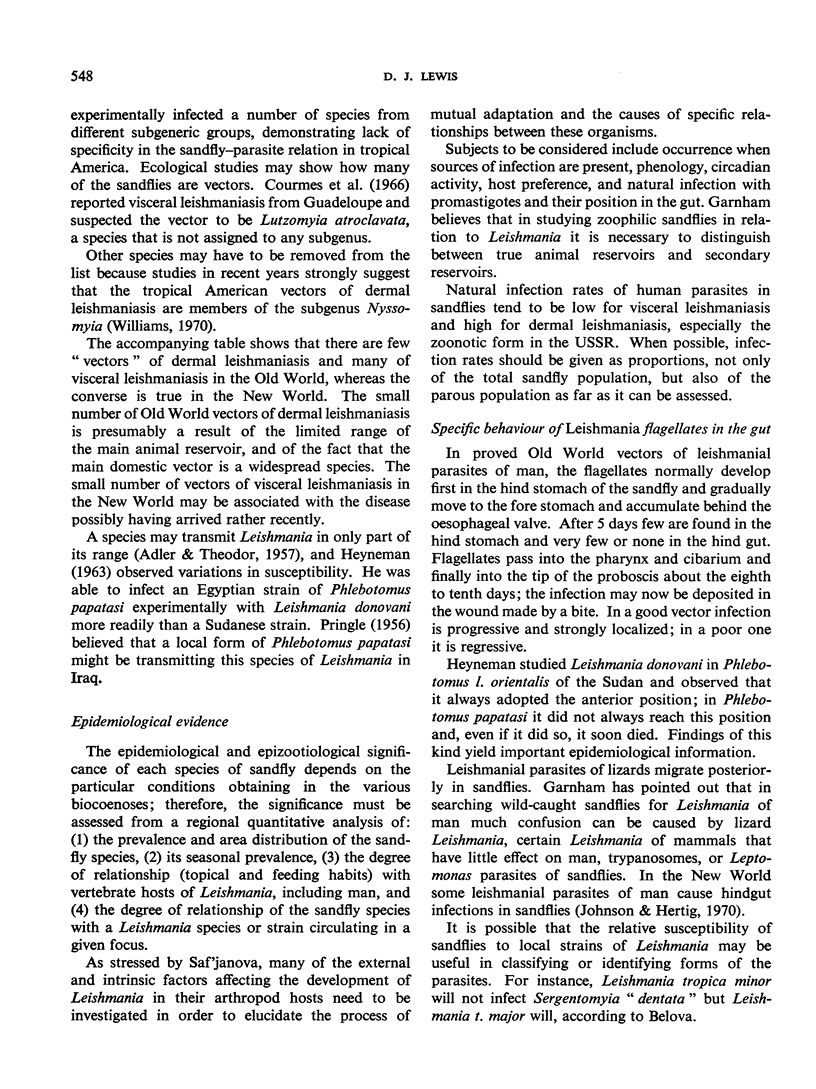

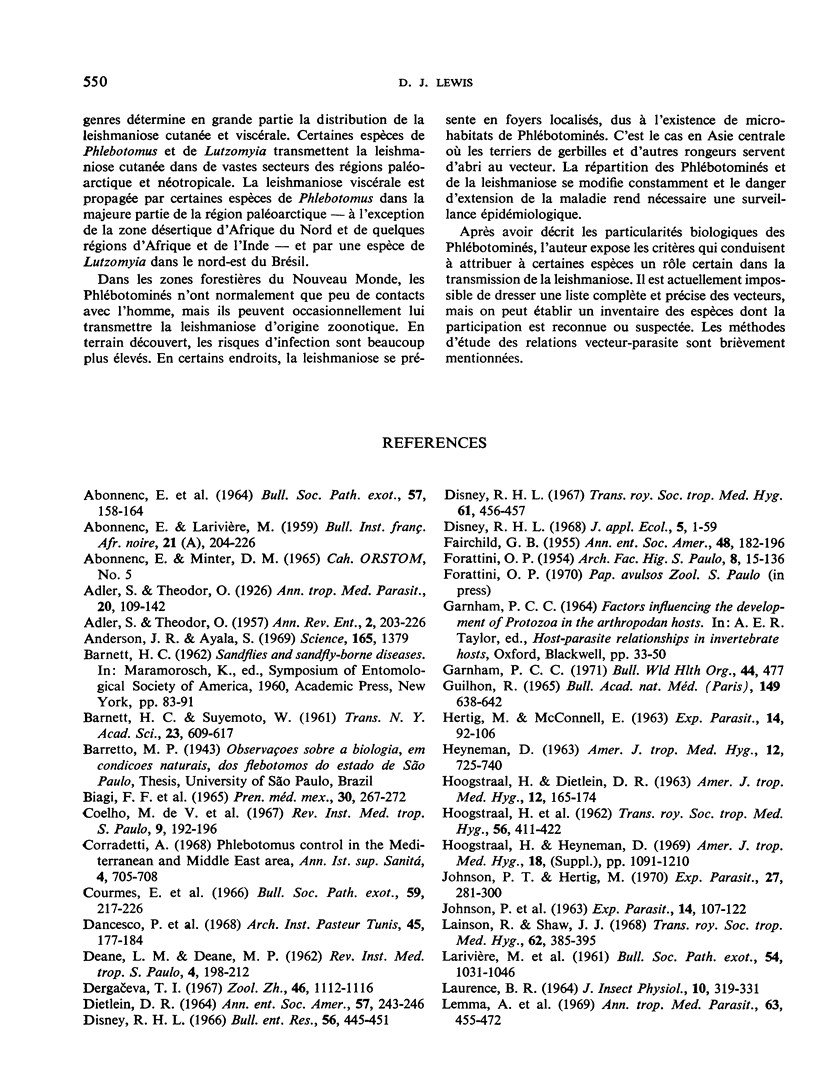
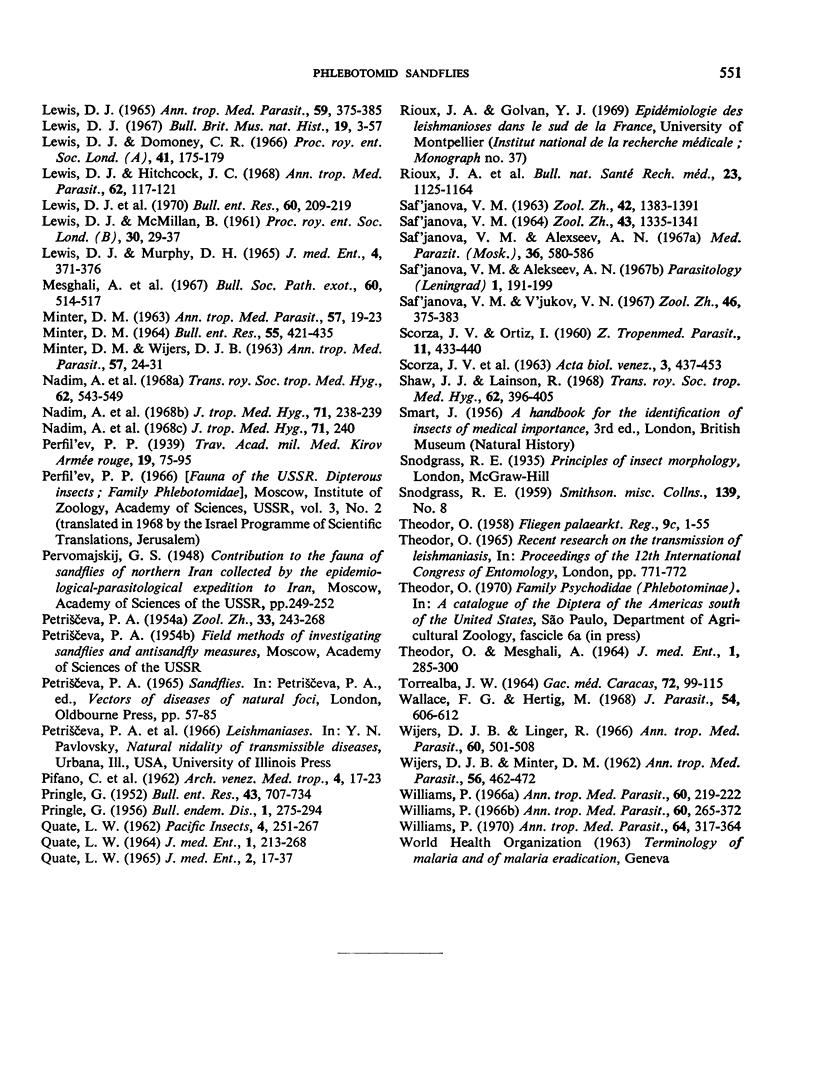
Selected References
These references are in PubMed. This may not be the complete list of references from this article.
- ABONNENC E., DYEMKOUMA A., HAMON J. SUR LA PR'ESENCE DE PHLEBOTOMUS (PHLEBOTOMUS) ORIENTALIS PARROT, 1936, DANS LA R'EPUBLIQUE DU NIGER. Bull Soc Pathol Exot Filiales. 1964 Jan-Feb;57:158–164. [PubMed] [Google Scholar]
- Coelho M. de V., Falcão A. R., Falcão A. L. Desenvolvimento de espécies do gênero Leishmania em espéies brasileiras de flebótomos do gênero Lutzomyia frança, 1924. II. Ciclo vital de L. tropica em L. longipalpis e L. renei. Rev Inst Med Trop Sao Paulo. 1967 Jul-Aug;9(4):192–196. [PubMed] [Google Scholar]
- Corradetti A. Phlebotomus control in the Mediterranean and Middle East area. Ann Ist Super Sanita. 1968;4(5):705–708. [PubMed] [Google Scholar]
- Courmes E., Escudie A., Fauran P., Monnerville A. Premier cas autochtone de leishmaniose viscérale humaine a La Guadeloupe. Bull Soc Pathol Exot Filiales. 1966 Mar-Apr;59(2):217–226. [PubMed] [Google Scholar]
- DEANE L. M., DEANE M. P. Visceral leishmaniasis in Brazil: geographical distribution and trnsmission. Rev Inst Med Trop Sao Paulo. 1962 May-Jun;4:198–212. [PubMed] [Google Scholar]
- Disney R. H. A trap for Phlebotomine sandflies attracted to rats. Bull Entomol Res. 1966 Jun;56(3):445–451. doi: 10.1017/s0007485300056510. [DOI] [PubMed] [Google Scholar]
- Garnham P. C. The genus Leishmania. Bull World Health Organ. 1971;44(4):477–489. [PMC free article] [PubMed] [Google Scholar]
- Gray A. R. Antigenic variation in clones of Trypanosoma brucei. II. The drug-sensitivities of variants of a clone and the antigenic relationships of trypanosomes before and after drug treatment. Ann Trop Med Parasitol. 1966 Sep;60(3):265–275. [PubMed] [Google Scholar]
- HERTIG M., MCCONNELL E. EXPERIMENTAL INFECTION OF PANAMANIAN PHLEBOTOMUS SANDFLIES WITH LEISHMANIA. Exp Parasitol. 1963 Aug;14:92–106. doi: 10.1016/0014-4894(63)90014-6. [DOI] [PubMed] [Google Scholar]
- HOOGSTRAAL H., DIETLEIN D. R., HEYNEMAN D. Leishmaniasis in the Sudan Republic. 4. Preliminary observations on man-biting sandflies (Psychodiae: Phlebotomus) in certain Upper Nile endemic Nile endemic areas. Trans R Soc Trop Med Hyg. 1962 Sep;56:411–422. doi: 10.1016/0035-9203(62)90016-0. [DOI] [PubMed] [Google Scholar]
- HOOGSTRAAL H., DIETLEIN D. R. Leishmaniasis in the Sudan Republic. 9. Ecological relationships of sandfly species and Leishmania infection. Am J Trop Med Hyg. 1963 Mar;12:165–174. [PubMed] [Google Scholar]
- Hertig M., Johnson P. T., McConnell E., Anderson J. R., Ayala S. C. Growth pattern of Leishmania in phlebotomine sandflies. Science. 1969 Sep 26;165(3900):1379–1381. doi: 10.1126/science.165.3900.1379. [DOI] [PubMed] [Google Scholar]
- JOHNSON P. T., MCCONNELL E., HERTIG M. NATURAL INFECTIONS OF LEPTOMONAD FLAGELLATES IN PANAMANIAN PHLEBOTOMUS SANDFLIES. Exp Parasitol. 1963 Aug;14:107–122. doi: 10.1016/0014-4894(63)90015-8. [DOI] [PubMed] [Google Scholar]
- Johnson P. T., Hertig M. Behavior of Leishmania in Panamanian phlebotomine sandflies fed on infected animals. Exp Parasitol. 1970 Apr;27(2):281–300. doi: 10.1016/0014-4894(70)90033-0. [DOI] [PubMed] [Google Scholar]
- LARIVIERE M., ABONNENC E., KRAMER R. [Chronicle of cutaneous leishmaniasis in West Africa. The problem of the vector]. Bull Soc Pathol Exot Filiales. 1961 Sep-Oct;54:1031–1046. [PubMed] [Google Scholar]
- LEWIS D. J., MURPHY D. H. THE SAND-FLIES OF THE GAMBIA (DIPTERA: PHLEBOTOMINAE). J Med Entomol. 1965 Jan;1:371–376. doi: 10.1093/jmedent/1.4.371. [DOI] [PubMed] [Google Scholar]
- Lainson R., Shaw J. J. Leishmaniasis in Brazil: I. Observations on enzootic rodent leishmaniasis--incrimination of Lutzomyia flaviscutellata (Mangabeira) as the vector in the Lower Amazonian Basin. Trans R Soc Trop Med Hyg. 1968;62(3):385–395. doi: 10.1016/0035-9203(68)90090-4. [DOI] [PubMed] [Google Scholar]
- Lemma A., Foster W. A., Gemetchu T., Preston P. M., Bryceson A., Minter D. M. Studies on leishmaniasis in Ethiopia. I. Preliminary investigations into the epidemiology of cutaneous leishmaniasis in the highlands. Ann Trop Med Parasitol. 1969 Dec;63(4):455–472. [PubMed] [Google Scholar]
- Lewis D. J., Hitchocock J. C., Jr Phlebotomine sandflies of Chad. Ann Trop Med Parasitol. 1968 Mar;62(1):117–121. doi: 10.1080/00034983.1968.11686537. [DOI] [PubMed] [Google Scholar]
- Lewis D. J. Internal structural features of some Central American phlebotomine sandflies. Ann Trop Med Parasitol. 1965 Sep;59(3):375–385. doi: 10.1080/00034983.1965.11686322. [DOI] [PubMed] [Google Scholar]
- Nadim A., Mesghali A., Amini H. Epidemiology of cutaneous leishmaniasis in the Isfahan province of Iran. 3. The vector. Trans R Soc Trop Med Hyg. 1968;62(4):543–549. doi: 10.1016/0035-9203(68)90141-7. [DOI] [PubMed] [Google Scholar]
- Nadim A., Seyedi Rashti M. A., Mesghali A. On the nature of leptomonads found in Sergentomyla sintoni in Khorassan, Iran and their relation to lezard leishmanias. J Trop Med Hyg. 1968 Sep;71(9):240–240. [PubMed] [Google Scholar]
- Nadim A., Seyedi-Rashti M. A., Mesghali A. Epidemiology of cutaneous leishmaniasis in Turkemen Sahara, Iran. J Trop Med Hyg. 1968 Sep;71(9):238–239. [PubMed] [Google Scholar]
- PRINGLE G. Kala azar in Iraq: preliminary epidemiological considerations. Bull Endem Dis (Baghdad) 1956 Jan;1(4):275–294. [PubMed] [Google Scholar]
- QUATE L. W. A TAXONOMIC STUDY OF PHILIPPINE PHLEBOTOMINES (DIPTERA: PSYCHODIDAE). J Med Entomol. 1965 Apr;2:17–37. doi: 10.1093/jmedent/2.1.17. [DOI] [PubMed] [Google Scholar]
- QUATE L. W. PHLEBOTOMUS SANDFLIES OF THE PALOICH AREA IN THE SUDAN (DIPTERA, PSYCHODIDAE). J Med Entomol. 1964 Oct;1:213–268. doi: 10.1093/jmedent/1.3.213. [DOI] [PubMed] [Google Scholar]
- SCORZA J. V., ORTIZ I. On microclimatic conditions of the habitats of certain sandfly species (Diptera, Psychodidae) from Venezuela. Z Tropenmed Parasitol. 1960 Dec;11:433–440. [PubMed] [Google Scholar]
- Shaw J. J., Lainson R. Leishmaniasis in Brazil: II. Observations on enzootic rodent leishmaniasis in the Lower Amazon Region--the feeding habits of the vector, Lutzomyia flaviscutellata in reference to man, rodents and other animals. Trans R Soc Trop Med Hyg. 1968;62(3):396–405. doi: 10.1016/0035-9203(68)90091-6. [DOI] [PubMed] [Google Scholar]
- THEODOR O., MESGHALI A. ON THE PHLEBOTOMINAE OF IRAN. J Med Entomol. 1964 Oct;1:285–300. doi: 10.1093/jmedent/1.3.285. [DOI] [PubMed] [Google Scholar]
- TORREALBA J. W. CONSIDERACIONES SOBRE EPIDEMIOLOG'IA DE LA LEISHMANIASIS VISCERAL EN VENEZUELA. Gac Med Caracas. 1964 Jan-Mar;72:99–115. [PubMed] [Google Scholar]
- WIJERS D. J., MINTER D. M. Studies on the vector of kala-azar in Kenya. I. Entomological evidence. Ann Trop Med Parasitol. 1962 Dec;56:462–472. doi: 10.1080/00034983.1962.11686148. [DOI] [PubMed] [Google Scholar]
- Wallace F. G., Hertig M. Ultrastructural comparison of promastigote flagellates (leptomonads) of wild-caught Panamanian Phlebotomus. J Parasitol. 1968 Jun;54(3):606–612. [PubMed] [Google Scholar]
- Williams P. Phlebotomine sandflies and leishmaniasis in British Honduras (Belize). Trans R Soc Trop Med Hyg. 1970;64(3):317–368. doi: 10.1016/0035-9203(70)90171-9. [DOI] [PubMed] [Google Scholar]
- Williams P. The distribution on the human body of bites inflicted by phlebotomine sandflies in British Honduras. Ann Trop Med Parasitol. 1966 Jun;60(2):219–222. doi: 10.1080/00034983.1966.11686409. [DOI] [PubMed] [Google Scholar]


